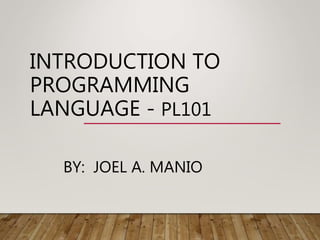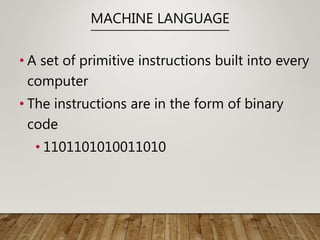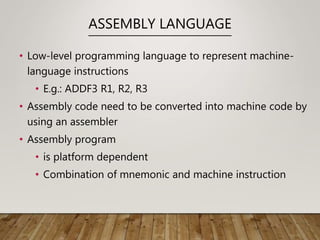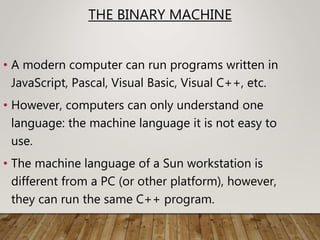ProgrammingIntroduction.ppt
- 1. INTRODUCTION TO PROGRAMMING LANGUAGE - PL101 BY: JOEL A. MANIO
- 2. PROGRAMMING LANGUAGE ? First-generation: Machine language ? Second-generation: Assembly language ? Third-generation: High-level language ? Fourth-generation ? (Fifth-generation)
- 3. MACHINE LANGUAGE ? A set of primitive instructions built into every computer ? The instructions are in the form of binary code ? 1101101010011010
- 4. ASSEMBLY LANGUAGE ? Low-level programming language to represent machine- language instructions ? E.g.: ADDF3 R1, R2, R3 ? Assembly code need to be converted into machine code by using an assembler ? Assembly program ? is platform dependent ? Combination of mnemonic and machine instruction
- 5. HIGH-LEVEL LANGUAGE ? English-like and easy to learn and program. ? E.g.: ? Area = 5 * 5 * 3.1415; ? COBOL, FORTRAN, BASIC, Pascal, Ada, C, Visual Basic, Delphi, C++, C#, Java ? Source program is compiled into machine code by a compiler and linked to supporting library code by a linker to form an executable file.
- 6. 4GL / 5GL ? 3GL offered greater power to the programmer, while 4GL open up the development environment to a wider population. (Applications Development Without Programmers) ? Database query languages: SQLˇ ? Data manipulation, analysis, and reporting languages: MATLAB, SPSSˇ
- 7. CATEGORY (3GL) ? Windows Application ? C, C++, Java, Visual Basic, C# ? Web Application ? Server Side ? PHP, JSP (Java), ASP.NET (Visual Basic, C#), ˇ ? Client Side ? JaveScript, VBScript
- 8. THE BINARY MACHINE ? A modern computer can run programs written in JavaScript, Pascal, Visual Basic, Visual C++, etc. ? However, computers can only understand one language: the machine language it is not easy to use. ? The machine language of a Sun workstation is different from a PC (or other platform), however, they can run the same C++ program.
- 9. TWO TYPES OF TRANSLATORS (3GL TO 1GL) ? Interpreter: ? translate and run the source code one line at a time. Easy to write and easy to find the errors in the program, but running very slow. ? JavaScript, VBScript, PHP, ˇ ? Compiler: ? translates the source code once and for all, producing a complete machine language program. Very fast, but when the program fails, difficult to show the programmer where are the errors. ? C, C++, Java, C#, and so on.
- 10. IMPLEMENT A LANGUAGE ? Generally, the action of any translating program can be divided into three phases ? Scanning ? Parsing ? Code generation
- 11. IMPLEMENT A LANGUAGE - SCANNING ? Scanning process: a long string of characters is broken into tokens. ? Example: sum = a + b is broken into 5 tokens sum, =, a, +, b ? A token is the smallest meaningful unit of information.
- 12. IMPLEMENT A LANGUAGE - PARSING ? Parsing: the string of tokens is transformed into a syntactic structure. ? What happens in a compiler or interpreter is that the list of tokens is converted to a parse tree in memory via a complicated algorithm. = sum + a b
- 13. PARSING A COMPLICATED EQUATION
- 14. PARSING A COMPLICATED EQUATION














